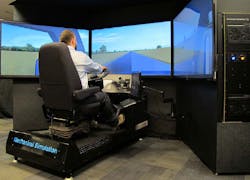Mechanical Simulation Corporation has delivered an innovative driving simulator to the National Transportation Safety Board (NTSB). The three degree of freedom (3 DOF) motion simulator features Mechanical Simulation's flagship vehicle simulation software product - TruckSim for Driving Simulators. The simulator will be used by NTSB engineers for accident investigation and development, testing and demonstration of accident avoidance and mitigation strategies.
This advanced driving simulator features an extended real-time Software-in-the-Loop (SIL) capability that enables NTSB engineers to interface with Matlab Simulink. This capability allows development and testing of alternate control strategies. In this application, Mechanical Simulation has developed integrated system architecture to manage the simulation of vehicle dynamics, motion control, motion cueing and MATLAB/Simulink models with a single computer. The simulator features three 70" high-definition monitors, a motion platform, driver controls, truck-style commercial seating, a torque motor to create realistic steering feel, instrumentation and controls for managing the simulation environment.
As a long-time user of TruckSim, the selection of a Mechanical Simulation driving simulator was the right solution for NTSB. Dr. Carl R. Schultheisz from NTSB said, "We worked very closely with Mechanical Simulation to define the performance and operational requirements of the simulator. This successful collaboration resulted in an open-architecture tool that we will be able to integrate with a wide range of accident investigation and engineering operations. With a TruckSim based simulator, we will be able to more quickly understand the unique characteristics of heavy duty and commercial vehicle accidents and to evaluate new technologies and accident avoidance strategies."
Since the simulator is designed as an engineering tool, the level of customization that can be accomplished by NTSB was also a compelling advantage. "We use TruckSim in desktop simulations because it allows us to control the physics in an accident scenario - the vehicle parameters and interactions with the road surface through th tires, suspension and braking," said Dr. Schultheisz. "In moving to the real-time driving simulator, our experience with TruckSim made the implementation fairly straightforward, and still allowed us complete control of vehicle properties, and the driving scene - complete with 3D models of vehicles. This lets us optimize all conditions to provide the most realistic driving experience for each investigation we want to demonstrate."


